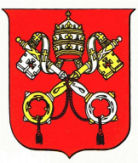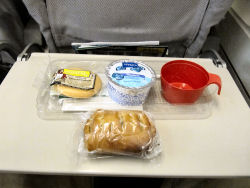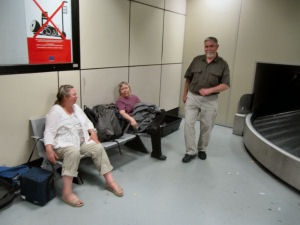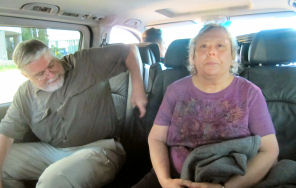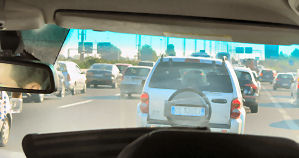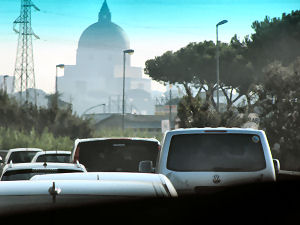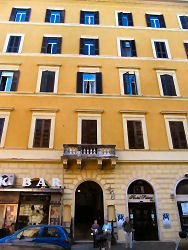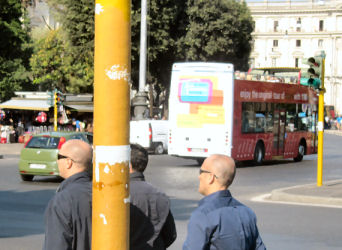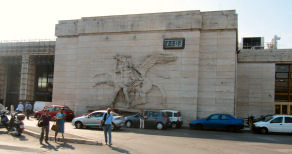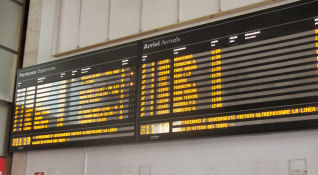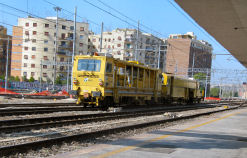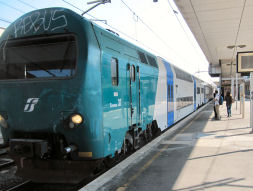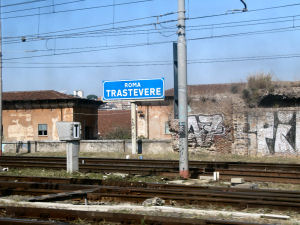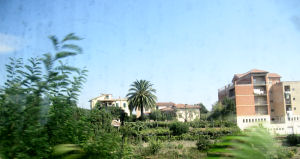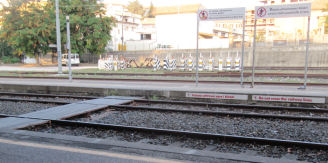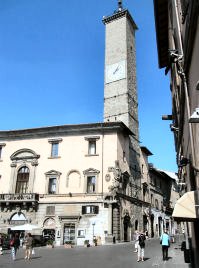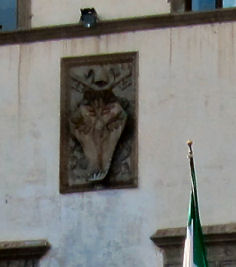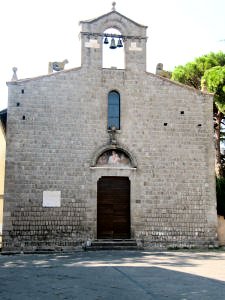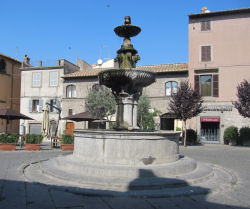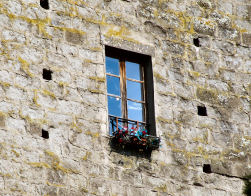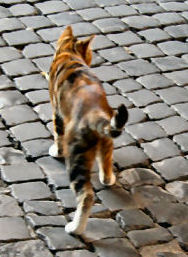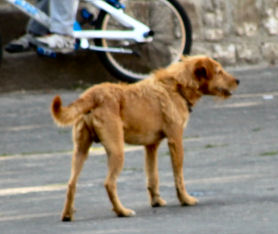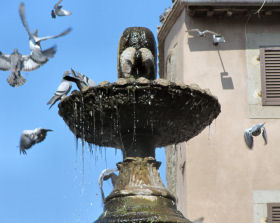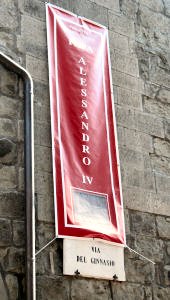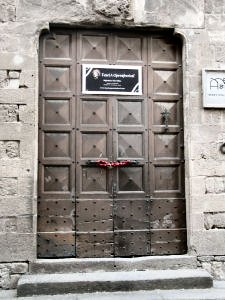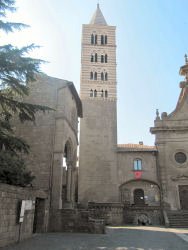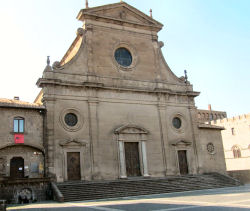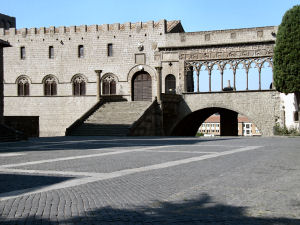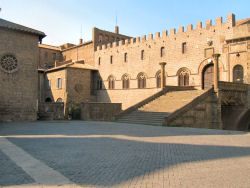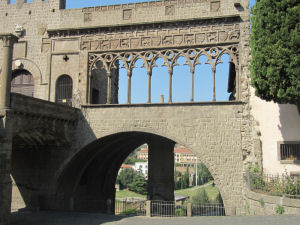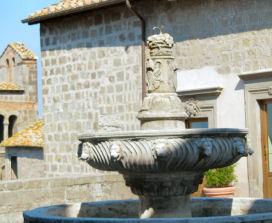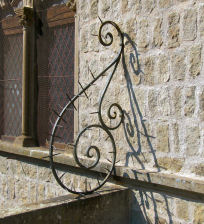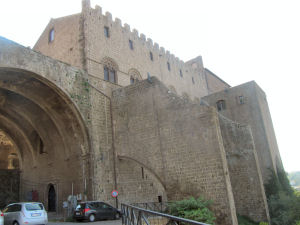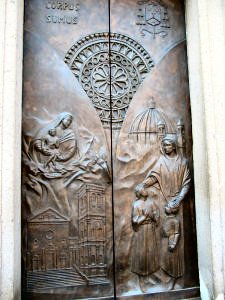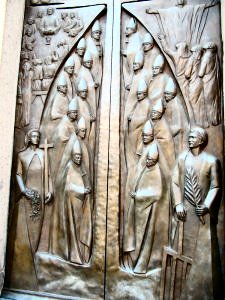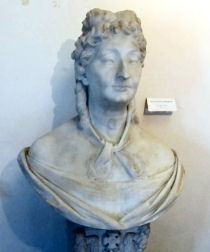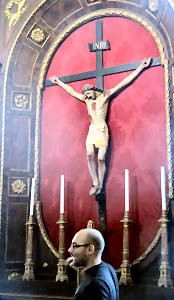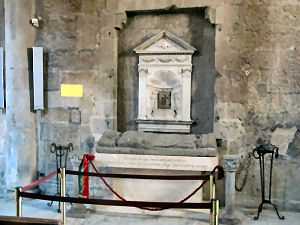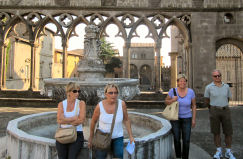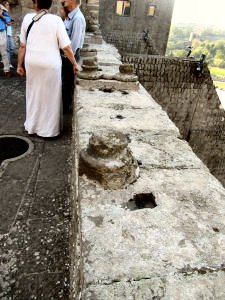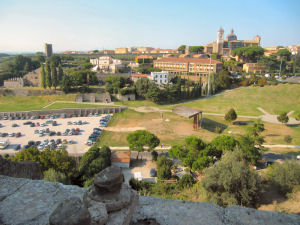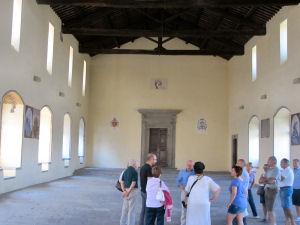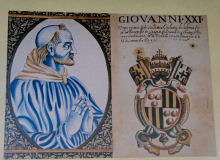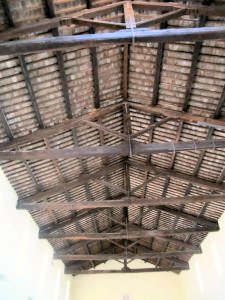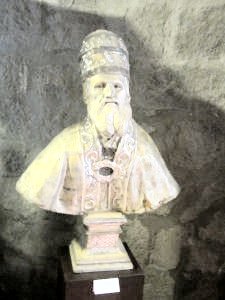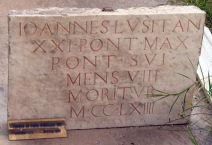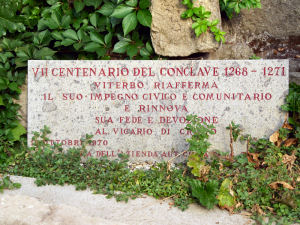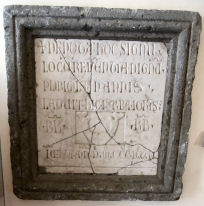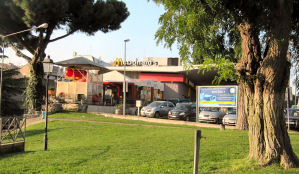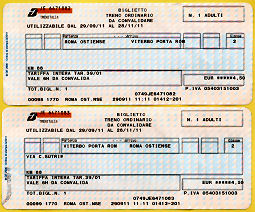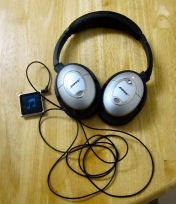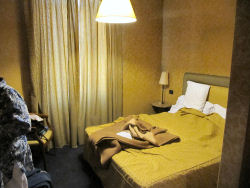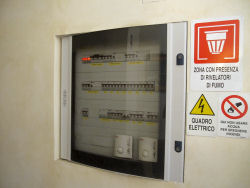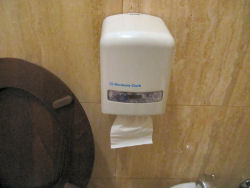The Alitalia crew woke us for breakfast at 6:30. I raised the plastic window shade to peer outside. I could see land below us, but there was not yet enough light to discern any features.
There is no shame in reporting that I felt groggy and a little sore as my eyes struggled to focus on the image of Kung Fu Panda on the TV suspended over the middle of the aircraft. Although the earpieces that they had distributed the previous evening were presumably somewhere in the pile of stuff at my feet, I resisted the temptation to discover what the ass-kicking bamboo-addict sounded like in Italian. Surprisingly, Sue did not seem much worse off than I was; her ankles have tended to swell up on these long flights and make her miserable.
The main attraction of the airborne breakfast was a brioche filled with Nutella. Each passenger also got a cardboard cup of yogurt. I swapped my raspberry with Sue for her blueberry. The strangest part of the breakfast was a package of Snickerdoodles cookies that were manufactured in Seattle. All of this was washed down with coffee and juice. The juice was fine, but the coffee was horrible. I am not sure whether Alitalia serves Italian coffee, American coffee, or something in between. Whatever it is, it needs work.After breakfast the sun had come up, and the sea was visible on the right. I tried to chart the plane’s progress as it overflew Italy’s west coast from Liguria through Tuscany and upper Lazio. I kept looking for the naval port at Civitavecchia, but I never spotted it.
By the time that the plane touched down at Leonardo da Vinci Airport in Fiumicino, we were only a few minutes late. This landing was not nearly as thrilling as when Sue and I first reached Italian soil at Malpensa in May of 2003, but it still gave me a rush. This was our third Rick Steves’ tour in Italy, and we also snuck into Piedmont after our tour of Paris and the South of France. In addition, Sue had spent a week or so in Sicily keeping Chick Comparetto out of trouble a few years back.Traversing the ground between the jetway and baggage claim was only slightly painful. We had to walk a good distance to the tram and then another good distance to baggage claim, but we were not forced to confront a bureaucracy. It never ceased to amaze me what a contrast had developed between the way that the U.S. treated visitors and the European approach. Passport control at Fiumicino was a complete joke; the official on duty just waved us through. He did not even stamp the passports. Maybe the budgetary crisis in Italy had limited their access to ink.
Our luggage was among the last to be delivered, but all four of us eventually located our bags. Customs in the airport was non-existent. I did not even see anyone in a uniform anywhere near the customs area. All the arriving passengers just strolled into the public area of the terminal.Just before we exited the secure area, Sue spotted a bancomat. I withdrew €250.[1] It was not a BNL bancomat, so we would probably be charged a transaction fee. I anticipated that we would have an immediate need for cash, however, because we had contracted to use the driving service that the hotel provided.
As we entered the main terminal we quickly spotted our driver, a young man clad in a dark suit who bore a sign that said “Micheal Wavada.”[2] He gave no indication that he spoke any English, but I was reasonably confident of my Italian in touristy situations. We followed him on a short but rather harrowing walk to his van, which was a black Mercedes. It was quite comfortable for four people even with all of our luggage.The drive to the hotel was more interesting than I had anticipated. At one point the car executed a hairpin turn from the autostrada onto some obscure street. The chosen route brought us past Basilica San Paolo, which the driver identified for us. I deduced that he had decided to drive south of the city to bypass some of the traffic. When we reached the city, I noticed that the car passed at least two BNL bancomats. Evidently it would not be as hard to find them in real life as it had been on the Internet. The driver skillfully manipulated the vehicle through quite a bit of traffic. He seemed to take some roundabout ways to reach the Hotel Selene on Via del Viminale, but it was evident that he knew what he was doing. Since we had previously negotiated a fixed fee of €60 for the trip, he had no incentive to dawdle or take a detour to Orvieto.
The driver pulled Mr. Benz over and let us off in front of the Hotel Impero. As we were obviously confused, he directed our attention across the street. Twenty or thirty yards up we spotted the small sign that identified our hotel. I paid the driver, and then we made our way across Via del Viminale into the reception area, which was in a rather small room to the right of the lobby area (such as it was). We checked in.Since it was only about ten o'clock and therefore much too early for our rooms to be ready, we just dropped off our luggage. It was a little difficult for the other three in our group to determine what to keep and what to leave as they had no firm idea as to what they wanted to do for the rest of the day. I convinced them that they should probably buy a ticket to bus #110, the hop-on, hop-off bus that makes a circuit of the city’s biggest attractions. I don’t think that it existed eight years ago, but from what I had read it seemed like a pretty good way to see some sights if you did not know your way around Rome.
The hotel provided us with some detailed street maps of Rome, and one of the guys at the desk explained to us that to reach Termini, Rome’s primary train station and the locus of nearly all kinds of public transportation, we just needed tp continue walking up Via del Viminale a few blocks. So we set off together. Despite the early hour, the temperature must have already climbed to close to 80 degrees. Patti needed some water, and Tom found a place on our route to buy her a bottle.
I had more ambitious plans. I intended to take the Metro from Termini to Piramide Station. Then I hoped to find the nearby Ostiense regional train and purchase a ticket for Porta Romana Station in Viterbo, which was due north of Rome. Why Viterbo? It had been the home of the popes for twenty-four years in the twelfth century when King Charles I of Naples was running the show in southern Italy. I knew that the Papal Palace in Viterbo was still relatively intact, and I wanted to see it as well as the church in which Henry of Almain[3] had been murdered in 1271 by his cousin, Guy of Montfort, before a standing-room-only crowd of nobles and church hierarchy.I asked the other people in the foursome if any of them wanted to ride up to Viterbo with me. I was not surprised that they decided to stay in Rome.
In the Piazza del Cinquecinto, a huge open area that separated Termini from the Baths of Diocletian, I left my fellow travelers to find their bus and purchase tickets on their own. I proceeded to seek out the Metro station and a place to buy Metro tickets. The piazza was a zoo, but I managed to find someone selling tickets in the exit from the station.[4] I then left the station, crossed through a gauntlet line of construction, and located the entrance. Sue had given me a map of the Metro system, so I knew that I wanted the B line and that the direction that I wanted to go was “Laurentina.”[5] A long twisting walk through construction brought me to the designated track. After a three-minute wait I boarded the crowded grafitti-covered train. I was on my way to my first adventure.
I got off at the fourth stop, Piramide. Eight years ago we had taken the same route to Ostia Antica. I had read on the Internet that there was a tunnel from the Piramide Metro Station to the Ostiense Station that served the regional railroads, but I could not find it, and I did not see any of the signs that the write-up on the Inernet had promised. I did find the Lido Station, which was where the train that we took in 2003 departed, but I was pretty certain that that was not the right station. I finally swallowed my masculine pride and asked a lady selling tickets in the Lido Station for directions. She told me to go out the door and turn right. I did that, and then I walked at least a couple of blocks. When I caught sight of a big fascist-looking building, I knew that I was in the right place. I located the biglietteria inside Ostiense Station and proudly purchased my €9 round-trip ticket ticket in perfect Italian. The lady selling tickets spoke to me in Italian and was not even condescending. I had taken off my Mystic Seaport cap before I got in line, and these regional trains are not favored by tourists, so she may have even thought that I was Italian. However, when I asked her “Quale binario?” the jig was up. I expected a number between one and twenty. Instead, I got a paragraph delivered in machine-gun Italian. I comprehended almost none of it and was reduced to “Non ho capito.” She then asked me if I spoke English. After I admitted as much, she explained that the track would be posted on the big board. The train was scheduled to leave at 11:52 and would be labeled "Viterbo PR." I should have asked her what the Italians called that electronic board, but I did not.I had to wait almost an hour for the train, so I must have just missed the previous one. They supposedly left hourly.
A train departed for Cesano, which is on the way to Viterbo, on track 12 at 11:37. After about thirty minutes the train for Viterbo appeared on the board. It would also depart from track 12. I looked for a machine to time-stamp my ticket, but I did not find one.
I noticed a great deal of graffiti in the Lido and Ostiense Stations, and many of the trains were festooned with hastily applied spray paint. Since few tourists visited this location, removal of graffiti there may not have been a high priority. I did not recall so much of it in Rome eight years ago, and I did not remember seeing any elsewhere in Italy.
I was the first one to board the train, and surprisingly few people joined me. It was a double-decker train, but no grown-ups seemed interested in going upstairs.As I sat there consulting one of the guidebooks that briefly described the journey to Viterbo, I suddenly realized that the train ride would require an hour and fifty minutes, not the fifty minutes that I had previously reckoned. I could not recall why I had thought that it would take less than an hour; maybe I was thinking about Saturday’s destination, Frascati. Even if everything went smoothly, this trip would certainly take all day. In fact, I became a little concerned about whether I would be able to accomplish everything that I had hoped for. If I had not stumbled around looking for the Ostiense Station, I probably could have gotten on the earlier train and saved an hour.
The train made many stops, and it eventually filled up. Its route went through Trastevere, which is the part of Rome on the wrong side of the Tiber, before circling around the western border of the Vatican and then up the northwest side of Rome and its suburbs through Bracciano, the halfway point, to Viterbo. I sat on the right side, which allowed me a very clear view of the dome of St. Peter’s Basilica. From my seat on the train Bracciano alone looked interesting; all the other stops seemed pedestrian. I found myself nodding off several times.A nun and another lady got on at the San Pietro station and sat across from me and conversed in Italian for a while. The lady exited the train after only a couple of stops. The nun, as I recall, departed at Cesano. It seemed much cooler in Viterbo as I descended the train just before two o'clock, the worst possible time. For two hours or so nearly everything in town would be closed except the eating establishments and the few stores that catered to tourists. In short, I could eat and walk around, but I could not really accomplish anything else.
We had arrived on track two. There was no officially sanctioned way to cross the tracks to get to the station. Instead, at one spot some plywood had been laid down between and next to the tracks. Most people crossed there. The ironic part was that the makeshift crossing was right next to a sign that said not to cross the tracks.
I immediately sought out the tourist information center at the Porta Romana train station. I had read very good things about it on the Internet; it supposedly was well stocked with pamphlets in English. I was disappointed but not surprised to find it closed. I resolved to try it again when I returned to the station.So, I was completely on my own in Viterbo. All that I had to guide me was the colored map that I had printed from the Internet, and the street names were not easy to read. I had to take off my glasses to decipher them.
Dozens, or maybe even hundreds of young people were milling around in the vicinity of the Porta Romana train station. They clustered in packs of two to ten people; they did not seem to be part of a single big group. I never did find out what they were doing in town. I did not even know if they were Viterbesi who were going on a day trip or out-of-town youngsters who had spent the morning in Viterbo.
Right across the street from the Viterbo Porta Romana train station was a McDonald’s. Actually, it was a combination gas station and McDonald’s. There was no drive-through, and there were no more that six or seven parking spaces. It was definitely lunch time in Viterbo.[6] In fact, I saw many young people near the train station carrying McDonald’s bags. I went inside and examined the menu. Nothing looked reasonable to me. I made use of the unisex restroom and then was on my way. McDonald’s was one of the few eating establishments in Italy that let people use its restrooms for free even if they purchased nothing.
Viterbo is one of many walled cities in Italy. I walked through the gate and then ambled along the narrow Medieval streets until I located the Piazza del Gesù and the church of San Silvestro, the site of the murder of Henry of Almain in the thirteenth century. The church wasn’t open when I arrived. I took some photographs of the bleak exterior and noted that it was a little smaller than I expected. I sat down on some stairs and petted a stray kitten in the nearby Piaza Del Gesù. I should have tried the church again later, but I never did. No doubt it has been remodeled many times in the more than seven centuries since the notorious event. I then made my way to Piazza San Lorenzo, the home of the Duomo, the Papal Palace, and the Museo del Colle del Duomo. Nothing was open, but I took a lot of pictures of the exteriors. There was also a pretty good view of the valley on the other side of the Papal Palace.I retraced my steps back to Piaza Del Gesù where I entertained myself by watching the pigeons flying into and out of the fountain, some boys messing around, and a dog with a weird haircut. This was not what I came to Viterbo for, but it was mildly diverting to become an unobtrusive observer of Italian street life. I was happy that at least I had not tried to cajole any other members of our party into making the trip with me.
On the way to Piazza San Lorenzo I came across a large red banner promoting a program about Pope Alexander IV, the first pope to settle in Viterbo. I could not, however, figure out where the event was being held or even what it consisted of.
Scattered throughout Viterbo were quite a few informational signs that documented various aspects of the city’s history and its ancient structures. I found one that provided quite a few details about the Palazzo Farnese, which was the home of Pope Paul III, whom it identified as the first great Renaissance pope, before he moved to Rome. Another described the city’s Etruscan walls and the Etruscan ruins that still lay beneath the Cathedral. I took photographs of both signs.
I never heard anyone on the streets or piazzas in Viterbo speak English or any language other than Italian. I guess that the town was definitely off the well-trod tourist path.
At about 3:15 I marched back to Piazza San Lorenzo and found the Duomo and the museum open. I entered the small museum. The man at the desk explained that for €3 I could look at the exhibits. For €7 I could join the group that was scheduled to assemble at 3:30 to tour the cathedral, its elegant and eccentric sacristy, its choir room, and the papal palace. This was an easy choice for me; I signed up for the tour. This whole transaction was in Italian, but the guy in charge switched to English to warn me that the tour would be conducted in Italian. However, he provided me with a large laminated cheat-sheet in English, and he assured me that it had almost all of the information on it. So, I spent the next quarter hour cramming for the tour.
The most intriguing fact that I gleaned was that a man named Vicedomino Vicedomini had evidently been elected pope in a conclave in Viterbo in 1276. The poor fellow died the same day that he was elected. He was sometimes called “quasi Gregory XI.” I had read dozens or maybe hundreds of books on the popes, but I had never encountered this fellow before. I had thought that the record for short-timers was held by Pope Stephen II, who died after three days and who was no longer on the official list.
The cheat-sheet said that Pope John XXI’s[7] tomb was located in the Duomo. The only thing that I remembered about him was that his number was weird. No pope named John ever took the number XX. I learned that Pope John was the only Portuguese pontiff ever.
Fourteen people gathered near the museum for the tour. The presentation was exceptionally good. I comprehended only about 60 or 70 percent of what the guide said, but I still appreciated it. Everyone else in the group was Italian. Three of the men wore shorts. I have previously noticed that very few Italians wear shorts. Two of these guys had extremely hairy legs that bordered on the furry[8]
The portions of the church that were included in the tour were quite interesting, and I felt confident that I snapped some pretty good photos. The sacristy was particularly full of interesting details. However, my attention was not fully engaged until we climbed the stairs, and the guide opened the door to the hall of the conclave. I took an excessive number of photos. I have never seen any photos on the Internet of the interior of this hall. I even took some photos of the wooden ceiling, which needless to say, they have replaced in the ensuing 750 years. You can read all about the popes in Viterbo here, but one aspect of the conclave bears repeating.
After Pope Clement IV, the third pope who resided in Viterbo, died in the city in 1268, the cardinals assembled in this hall to elect his successor. At that time the Anjou family exerted a great deal of influence in the Church. King Louis IX had twice abandoned the French throne to organize crusades, and he perished in the process. His brother Charles had been hired by the pope to cleanse southern Italy of the remaining influence of the successors to Emperor Frederick II. Not long before the pontiff died, Charles had beheaded Conradin, Frederick II’s teenaged grandson. The cardinals were divided between those who were indebted to the Anjous and those who favored the emperor’s cause. Not much is known for certain about the actual proceedings other than the fact that one of the twenty cardinals did not attend. For over two years the cardinals could not decide on a pope. Eventually all of the following occurred:- The cardinals were locked into the hall. Previously they had met once a day (or less frequently) to vote and then went back to their residences.
- Carpenters were called in to remove the roof of the hall to put more pressure on the cardinals to elect a pope.
- Rations were cut severely to the point that the cardinals were only given bread and water.
- Three cardinals died.
- A committee of six cardinals, a sort of Super-Congress, was chosen to select the next pope.
- The man selected, Tebaldi Visconti, was in Acre with the ninth crusade. He was not even a priest.
- Visconti became Pope Gregory X, but he did not actually take office until 1272!
I was really delighted at the opportunity to see and photograph the extremely famous room in which the cardinals had so often convened to elect popes. It made the famous conclave of 1268-1271 seem much more real to me, and it made the long trip and the wait worthwhile.
Everyone in the tour group walked through the museum. It was much larger than I had thought, and more of it than I expected was devoted to archeology. I had read on the Internet that they had the chin of John the Baptist[9] in a reliquary. If they did, it was not very well labeled; I could not find it. I did locate a plaque that said that the jawbone of some saint named John had been found in the cathedral in Viterbo. I also found a reliquary bust of Pope Pius V, the saintly pope who schemed with Catherine de' Medici to massacre the Huguenots.
After I left the museum I should have gone back to San Silvestro and peeked into the interior of the church. Then I should have chased down the famous Macchina[10] of Santa Rosa. I did neither of these things. I felt a little nervous about using the Metro after dark, so I decided to cut short my adventure in Viterbo and return to the hotel. I consulted my map and tried to plot the way back to the Porta Romana train station. Unfortunately, I lost my way and ended up going out the wrong gate. I then compounded my mistake by turning in the wrong directions. So, I could not find the train station. I had to ask directions from a pedestrian. By the time that I retraced my steps, I had missed the 4:56 train.
When I finally arrived, the train station was virtually empty, so I checked the schedule. Aaaaargh! There were, as I had earlier noted, trains every hour at fifty-six minutes after the hour. However, for some reason no train was scheduled to depart at 5:56. So, I had almost two more hours to kill, and I would not get into Rome until nearly nine o'clock even if everything went smoothly. Would the Metro even be running? I had seen signs that Linea A only ran until nine. The Viterbo train station definitely had a machine for time-stamping the tickets. I used it and surmised that the one in Ostiense probably did, too. Oh, well. No one on the train from Rome checked our tickets. My experience is that the chances of someone checking your ticket on an Italian train are 10 percent or less. Eight years ago, however, I did witness some people thrown off of the train in the Cinque Terre.
I walked around to the front of the station. The tourist information office was still closed. Maybe it was closed for good, or maybe it only operated during the summer. There was no sign of life there at all.
I had a lot of time to kill, and my metabolic clock informed me that it was almost lunch time. I returned to McDonald’s to get something to eat. A sign advertising McWraps warned that they were out of beef. That was fine with me; I wanted nothing to do with whatever passed for beef at an Italian McDonald’s. The available wrap was chicken (not pollo, mind you, chicken). I ordered one with a large Coca Cola Light.[11] I watched the young lady fill a cup with Coca Cola (not light) while she was also engaged in four or five other tasks. When she brought it to me, I reminded her that I had ordered Coca Cola Light. She set the first cup aside and started to fill a cup with Coca Cola Light. She seemed oblivious to the large tub of ice and the stainless-steel ice scoop clearly visible beneath the soda dispenser. I had to ask her twice for ghiaccio. She seemed taken aback by my request, but she eventually brought me a cup that would have qualified to be at most a medium in the states. It was cold, sweet, and wet. I was hot, bitter, and dry. It suited me. A little later she brought the wrap.I found an unoccupied table (a precious find in Italy) and extracted my laptop from my trusty backpack. I planned to take advantage of this unexpected delay to catch up on this journal while I consumed my yummy wrap. A McWrap, or at least the Italian version, was basically a few chicken McNuggets surrounded by some greens in a pita. I took a bite and was astonished to discover that the greens were arugula. Arugula at a McDonald’s! What was the world coming to?
After a short while I could not stand to be in the McDonald’s any more. I went back to the train station and found a concrete bench. I set up my computer on my lap with my wireless mouse.[12] I alternated between working on the journal and playing Spider Solitaire for an hour or more.
A young (who isn’t?) man in a business suit came up and sat beside me on the bench. I noted that he had the same kind of weird sideburns as the two guys on the airplane. This gentleman carried a briefcase that contained an iPad and an iPhone.
After a while quite a few people started to assemble on the platform. One of them was a nun wearing a habit with sandals. I was virtually certain that this was the first time that I had ever seen a nun’s pedal digits. How big a sin is it to look at a nun’s toes? It did not seem to me to qualify as a mortal sin, and I was confident that I had piled up an ample supply of indulgences in my younger days. So, I feasted my eyes.The train arriving from Ostiense was four minutes late. After its stop in Porta Romana I suspected that it went up to the other station in Viterbo, Porta Fiorentina, and then turned around. It certainly went no farther than that.
The train heading for Rome arrived about ten minutes later. It went quite a long way down the track past my bench. I gathered my stuff together and this time chose the upper compartment. The train tarried there for several minutes. Before it had even departed, I realized that I must have left my wireless mouse on the bench. I thoroughly searched my backpack, but I could not find it. I went so far as to depart the train to see if it was on the bench. It was too far away for me to tell. I got back on the train because if the train left with my backpack but not me, my mistake would evolve into an outright catastrophe.
God, how I hate it when I do – or, more commonly, forget to do – stupid things like that. The laptop that I brought was almost unusable without a mouse.
I tried to work on the computer, but the touchpad really annoyed me, and I soon gave up. By the time that we reached the second stop, it was dark outside. The train had good lighting, however, so I pulled out one of my guidebooks and tried to make a little better plan for my time for the next three days.
Almost immediately the temperature on the train dropped precipitously, and a guy in the back of the car began to play a DVD with the sound up pretty high. The situation got more and more annoying, but I was pretty well-equipped to deal with the new problems. I retrieved my jacket and my iPod Nano from my backpack. I listened to Pavarotti and Sutherland in La Traviata the rest of the way on my Bose headphones.I wondered whether winter had arrived or whether the air conditioning on the train was just set too high. I got my answer at the next stop where I espied a couple who were perhaps in their twenties. She had on a short black spandex dress. He was also wearing black – nylon workout pants and a sleeveless tee shirt. They seemed quite comfortable standing on the platform.
By a strange coincidence they both entered my car and ascended the stairway to the upper level and sat across the aisle from me. She must have been very cold because she literally climbed onto him, and he warmed her up by rubbing her thighs. This went on for at least a half hour. Then they got off the train.[13]
I took a little time to read my chapter on the popes from Viterbo. I determined that it definitely needed some work.
Shortly after the snuggling couple departed it began to warm up on the train, and before Violetta even decided to return to Paris, we were in Ostiense Station. From this side it was easy to find the tunnel to the Piramide Metro station. I took the Metro back to Termini, where I arrived a little after nine.
As I walked down Via del Viminale I was surprised to see Sue and Tom eating at a sidewalk cafe. Patti, they told me, was sleeping. They invited me to join them, but I described the delicious McSupper that I had consumed in Viterbo and demurred.Instead I went to the hotel’s reception desk and asked for the key to room 408. The man there told me that he needed to see my passport. I gave it to him. He recorded the necessary information and gave me the room key, which was an electronic card, and my suitcase.
I took the elevator up to the fourth floor. I had to use the key card to enter our section of the building, to enter the room, and to activate the electricity. Knowing that the battery on my computer was quite low, I immediately plugged my Radio Shack converter/surge protector into the wall. I attached my computer’s power supply cable and immediately everything went dark.I went back down to reception to tell the man at the desk that I had probably overloaded the circuit. At first he was convinced that I had failed to put the key card in the slot that activated the electricity. Eventually he concurred with my assessment of the problem and told me that his “colleague” would handle it. I expected the power to be out for several hours, but by the time I got back to the fourth floor the problem was solved. It occurred to me that for the first time in our European excursions every electrical device that we had brought with us could handle the European current. We could get buy with just the other converter and the adapter. I decided that I had endured enough problems with the Radio Shack converter and tossed it in the trash can.
I unpacked my clothes and realized that I had failed to pack the two buttoned and collared short-sleeve shirts that I had decided to bring. I could either make do or buy something. This was annoying, but it certainly was not a crisis of the order of magnitude of the pants debacle of the trip to Russia.A few minutes later Sue brought me a veal cutlet sandwich that she had left over from her supper on the sidewalk. I ate it, but it tasted more like chicken than veal. Sue said that that was her opinion, too.
I asked Sue what she, Patti, and Tom had done that day. She reported that they had gone to the Spanish Steps on the hop-on, hop-off buss, but she did not have much to say about their activities. Evidently Patti did not have much energy. They also purchased a gelato or two.
The day in Viterbo had certainly brought its share of failures,[14] but I did accomplish the primary objective of seeing the Papal Palace firsthand. It had by no means been a sure thing that I would be able to get to go inside the Hall of the Conclave, and I felt content.
When I undressed I discovered a blister on the second toe on my right foor. I would need to be a little careful because I expected to do just as much walking on Friday as I did in Viterbo. I took a shower, collapsed on the bed, and slept like a log.
[1] The exchange rate in the fall of 2011 was approximatly €1=$1.35.
[2] I should have asked him for the sign, but it did not occur to me.
[3] Sometimes called Henry of Cornwall.
[4] There are many much easier ways to buy Metro tickets.
[5] Linea A goes from Anagnina to Battistini. Line B goes from Laurentina to Rebibia. They intersect at Termini.
[6] On the other hand, from the point of view of my body’s clock it was only seven in the morning.
[7] John XXI is one of the least important popes. He accomplished almost nothing in the eight months of his pontificate. The visit motivated me to look up his history, however, and I discovered a few interesting facts. For example, he was the only pope who was also a physician. In fact, his medical practice directly led to his untimely demise. Upon assuming the papacy he ordered the construction of an apartment appended to the palace so that he could pursue his medicinal studies in private. Unfortunately, the roof caved in and killed him. This unusual version of the familiar "death in the hermetically sealed room" seemed to me like a good source for a mystery story. I mean, come on, the roof of a newly constructed apartment collapsed, and no one died but the pope?
[8] When I told Tom that I now understood why so few Italian men wore shorts, he asked if it was because they had knobby knees. I chastised him severely for his ignorance. Knobby knees have always been considered esthetically pleasing and, in fact, a mark of classically elegant comeliness.
[9] For some reason relics of John the Baptist are very common. One medieval church even claimed to have the skull of John the Baptist as a young man. Umberto Eco’s novel Baudolino contains a character who made a good living in the Middle Ages manufacturing heads of John the Baptist.
[10] A tower that is thirty meters high and weighs about four tons. It is carried through the streets of Viterbo by about one hundred men every September 3.
[11] The word "diet" seems to be anathema in Europe, or at least Coke and Pepsi think so.
[12] A month before this trip I purchased the Walmart back-to-school special Compaq laptop. I found the touchpad unusable, but in other respects it worked fine.
[13] I am fully cognizant of the fact that this vignette screams for photographic documentation. I had my camera at my fingertips, but I did not use it. If I had, the guy would probably have reacted badly, in which case I would have had to administer a sound whipping. I fostered no desire to humiliate the poor fellow.
[14] It later occured to me that a hand-held GPS might have saved me some grief in Viterbo.
